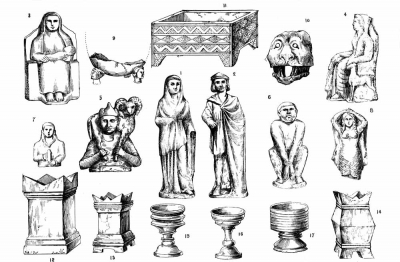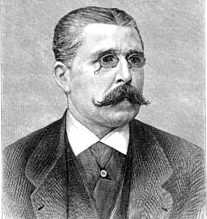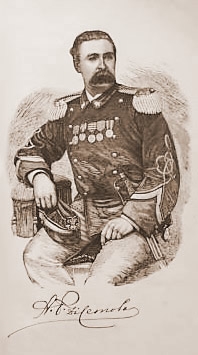Pitt-Rivers purchased many archaeological artefacts from the Cesnola collections for both his first (founding) collection and his second. Most came from auction houses, especially Sotheby's. Almost all the artefacts were thought to have been found in Cyprus.
Background
Artefacts that are associated with the name 'Cesnola' may have come from two sources, either Luigi or Louis Palma di Cesnola (1832-1904) or his brother Alexandro or Alessandro Palma di Cesnola (1839-1914).
Luigi di Cesnola is often referred to as 'General Cesnola'. He was born in Turin and served as a soldier. In 1860 he moved to New York where he taught languages. He was United States Consul to Cyprus between 1865-1877 where he carried out extensive, but controversial, excavations at Kourion, Larnaca, Salinos, Paphos, Soli and Pali and also purchased antiquities. In 1870 he carried out negotiations with Napoleon III to transfer the collection to the Musée du Louvre and with Russian officials regarding the sale to the Hermitage Museum in Saint Petersburg. These negotiations were not successful and he exhibited his collection in London, where Pitt-Rivers may have seen it. In 1872 the Metropolitan Museum in New York purchased many of the items in his collection. To find out what his contemporaries thought of this collection, see here. In 1879 he became the Director of the same Museum and remained in this post until his death. His collection was sold by Sotheby's in several separate sales after 1866.
Alexandro or Alessandro Palma di Cesnola is sometimes known as Major di Cesnola. He was also a soldier, lived in South America from 1870-3, when he moved to the United States. He first visited Cyprus in 1873 later US vice-Consul in Paphos. At the end of 1875 he travelled to London where he 'studied' at the British Museum. He returned to Cyprus in 1876. He also carried out excavations in Cyprus.
The Cesnola collections are often called the Cesnola-Lawrence collections. Edwin Henry Lawrence was Alessandro's father-in-law and helped to fund his excavations. In return he was given many of the objects that Alessandro excavated which he sold off in a series of sales. His introductions give you some information about the background to the ownership and sales of these artefacts. Items known as coming from the Lawrence-Cesnola collection were always found by Alessandro. He published an album describing some of his finds in 1881.
Pitt-Rivers purchased items excavated by both brothers from a number of sales over a period of more than twenty years, collecting all of them indirectly through Sotheby's, the auction hous; or from dealers who had previously purchased at auctions.
In the sale catalogues of the 'Collection called the Lawrence-Cesnola Collection' held at Sotheby, Wilkinson and Hodge on 1-4 June 1883, 15-17 May 1884, 12-14 March 1888. 25-27 April 1892, E.H. Lawrence wrote introductions which are transcribed in full here. Pitt-Rivers must have seen, or owned, a copy of these catalogues as he bought extensively from the sales. The frontispieces of the sale catalogues can be read here.
There are 193 objects from the Cesnola collections in the founding collection donated in 1884 to the University of Oxford, of which 187 are now thought to have been made in Cyprus though they are all recorded as having been found there. Trade is not a modern invention, and there was much trade across cultural areas throughout history and most collections, including the Cesnola collections, reflect this. Almost all of these objects are known to have been acquired by Pitt-Rivers through Sotheby, Wilkinson and Hodge, the auctioneers based in London [184 of the total 193 Cesnola objects in the founding collection]. It is possible that the remaining artefacts were purchased from Sotheby's as well. He purchased many objects for the founding collection at Sotheby's on 15 May 1884 but other dates include 3 July 1871, 21 March 1877, 1 May 1877, 22 February 1878, 1-2 July 1879, 1-4 June 1883, and 15-17 May 1884.
Note that a number of items are known to have been part of the founding collection by 1874 when they were displayed at Bethnal Green Museum, but their purchase date is not known. Pitt-Rivers must have owned some of them by 1871 when he and J. Wickham Flowers exhibited some Cypriote objects at the Society of Antiquaries. Again between 16 and 30 January 1873 he exhibited 25 examples of Cypriote metalwork at an exhibition of Bronze Weapons and Implements at the same place. He is thought to have acquired at least four Cesnola items via another dealer, Rollin et Feuardent. [1884.39.31-32, 1884.58.43-44] It is possible that there are a further 14 or so artefacts from the Cesnola collections in the founding collection which have not yet been accessioned.
There are 593 objects from the Edwin Henry Lawrence and Alessandro Palma di Cesnola collection in the Pitt-Rivers' second collection. These were acquired from a number of sources of which the auctioneers Sotheby's were the most important. Many artefacts were purchased from Sotheby, Wilkinson and Hodge on 1 June 1883 [207], many more from the same auctioneers on 15 May 1884 [121 objects], more items between 12 and 14 March 1888 [220]. A small number of Cesnola pieces are undated. 17 objects were also obtained from George Fabian Lawrence, a Wandsworth based dealer and antiquary and a small number from several other dealers who sold objects that they too had acquired at the Sotheby's sales. There is also 19 objects from Luigi di Cesnola in the second collection.
It is interesting that a few items from the Sotheby's sale on 15 May 1884 were sent to the South Kensington Museum by Pitt-Rivers, and were therefore transferred to Oxford, whilst the majority of the items purchased then were kept with his second collection, first being held at his London home in Grosvenor Gardens, then at Rushmore (his house on Cranborne Chase) and finally displayed in Room 9 of his private museum at Farnham, Dorset. This collection is now dispersed. The Cesnola pieces in the Pitt Rivers Museum (many of which are on display throughout the museum) have been published recently see Vasos Karagiorgis' book Cypriote Art in the Pitt Rivers Museum, University of Oxford. A. G. Leventis Foundation [2009]
Sales from which Pitt-Rivers (or Lane Fox) purchased Luigi and Alessandro Cesnola's objects
Pitt-Rivers seems to have purchased items from the Cesnola collection from very early on in his collecting career. The E.H. Lawrence - Alessandro Cesnola artefacts were not sold until 1883 so any items that predate this must come from the Luigi di Cesnola excavations or collections.
Here is a quick list of all the Sotheby sales of items from Cyprus that he is known to have collected from:
Sale on 1-2 May 1871:
See here for all the Lane Fox successful bids, and names of other successful bidders
Sale on 3 July 1871:
See here for all the Lane Fox successful bids, and names of other successful bidders
Sale on 24-25 June 1873
Fox does not appear to have purchased any of the items for sale at this auction; although the frontispiece makes reference to 'Ancient Pottery, Glass, Jewellery &c recently discovered in Cyprus', but with no reference to Cesnola.
Sale[s] of unknown date[s], but prior to 1874:
The following objects from the founding collection seem to have been acquired by Fox before 1874 as they were displayed at Bethnal Green Museum by the opening of those displays but the sale[s] at which they were acquired has not been recorded, or the documentation has been lost in the intervening 140 years: 1884.38.1-2, 4-7, 14, 21, 34-38, 44-46, 71-73, 76-77; 1884.39.1-2, 5-6, 10-16, 20-22, 25-30, 36-40; 1884.56.91-93, 97; 1884.63.67-71; 1884.67.54; 1884.68.115-116; 1884.119.16-18, 20, 22, 227, 280-285, 323-326, 328-336, 338-339, 388.
Possible sale circa 15 October 1875:
1884.39.4 is listed as having been purchased, and delivered to Bethnal Green / South Kensington Museum on 15 October 1875. The annotated sale catalogue for a sale where this object was purchased has not been identified.
Sale on 1-3 June 1876
Fox does not appear to have purchased any of the items for sale on one of these days 'in a section headed 'Antiquities found in the island of Cyprus', and with no reference to Cesnola. See here for the frontispiece to this sale.
Sale on 21 March 1877:
See here for all the Lane Fox successful bids, and names of other successful bidders.
Possible sale circa 22 February 1878:
1884.38.17, 27, 31, 75; 1884.39.34-35 are listed as having been purchased, and delivered to Bethnal Green / South Kensington Museum on 22 February 1878. The annotated sale catalogue for a sale where these objects were purchased has not been identified
Sale 8 April 1878:
1884.39.3, 18 are listed as having been purchased, and delivered to Bethnal Green / South Kensington Museum on 8 April 1878. The annotated sale catalogue for the sale where these objects were purchased has been identified but no matching lots have been identified, however, not all the sale catalogue has been examined. See here for the frontispiece for this sale.
Possible sale circa 28 June 1878:
1884.39.7 is listed as having been purchased, and delivered to Bethnal Green / South Kensington Museum on 28 June 1878. The annotated sale catalogue for a sale where this object was purchased has not been identified.
Possible sale circa 1-2 July 1879:
See here for a transcription of the frontispiece from this sale. 1884.39.23, 31-32; 1884.58.43-44 are listed as having been purchased, and delivered to Bethnal Green / South Kensington Museum just after this 1879 date. The annotated sale catalogue for the sale where these objects were purchased has been identified but no matching lots have been identified, however, not all the sale catalogue has been examined.
Possible sale circa 18 March 1881:
1884.38.39; 1884.119.286 are listed as having been purchased, and delivered to Bethnal Green / South Kensington Museum on 18 March 1881. The annotated sale catalogue for a sale where these objects were purchased has not been identified
Possible sale circa 5 April 1881:
1884.119.322 is listed as having been purchased, and delivered to Bethnal Green / South Kensington Museum on 5 April 1881. The annotated sale catalogue for a sale where this object was purchased has not been identified.
Sale on 28 May 1883
See here for all the items Pitt-Rivers acquired during this sale.
Sale on 1-4 June 1883:
See here for all the items Pitt-Rivers acquired during this sale
Sale on 15-17 May 1884:
See here for all the items Pitt-Rivers acquired during this sale
Sale[s] of unknown date[s], but prior to 1885:
The following objects from the founding collection seem to have been acquired by Fox before the founding collection was transferred to the University of Oxford in 1885 but the sale[s] at which they were acquired has not been recorded, or the documentation has been lost in the intervening 140 years: 1884.38.15, 26, 28, 30, 40, 50; 1884.39.8; 1884.119.19, 21; 1884.140.32 [no further information available]
Sale on 12-14 March 1888:
12.3.1888: Items acquired by Pitt-Rivers
13.3.1888: Items acquired by Pitt-Rivers
14.3.1888: Items acquired by Pitt-Rivers
Summary of 1888 sales
Sale on 25-27 April 1892:
See here for the items purchased by Pitt-Rivers at this sale
Possibly Sale circa 8 May 1897:
Add.9455vol4_p1480 /1 (item came in via GF Lawrence, this date is associated with the purchase)
Items from probable undated sales before 1900 recorded in catalogue of the second collection:
Add.9455vol2_p16 /36-43, Add.9455vol2_p17 /1-19, Add.9455vol7_p2094 /2 (but this is another items from GF Lawrence, see above), Add.9455vol7_p2131 /1-2, and Add.9455vol9_p2254 /3
See here for a list of all the known successful bidders for items from the Cesnola collections' sales at Sotheby's
See here for a description of the sales associated with the Cesnola items in the founding collection [written by Marina de Alarcón and Jeremy Coote in 2009].
See here for a list of items from Cyprus in the catalogue of the Pitt-Rivers' second collection which may be connected to the Cesnola collections (or might not).
Other Cesnola sales from which we don't know if Pitt-Rivers purchased items:
Sale on 25 May 1870 described as 'A [sale] catalogue of a collection of Ancient Pottery and Glass from Tombs recently opened in the Island of Cyprus'; sale on 8 January 1871 was described in its frontispiece as
'A [sale] catalogue of a very interesting collection of Early Greek Antiquities, consisting of Archaic Greek Pottery of the fifth century B.C. Antique Glasses, Bronzes, and a great variety of gold personal ornaments, gold mortuary diadems &x. discovered in the island of Cyprus on the sites of the Ancient Cities of Paphos, Idalium, Golgoi, &c. during the last four years by General di Cesnola, American Consul at Paris to which is added ...'; '
Note that the sales listed above which are titled 'Possible sales circa ... '. may of course just be dates upon which Pitt-Rivers delivered items he had acquired at some date or year before this rather than the actual date of a sale. They are all taken from documentation provided by the South Kensington Museum receipts.
Please note: there may have been sales of Cesnola artefacts from which Pitt-Rivers did not purchase (and we do not know about). In addition there are numbers of objects in the founding and second collections which are known to have come from one or other Cesnola collection but which are not associated with specific dates (the ones from the founding collection are marked below under the possible sales by X date headings), these type of objects from the second collection are also listed
Further Reading
1871 Catalogue of a very interesting collection of early Greek antiquities, formed by General de Cesnola, American Consul at Cyprus. [Catalogue of a very interesting collection of early Greek antiquities : consisting of archaic Greek pottery of the fifth century B.C., antique glass, bronzes, and a great variety of gold personal ornaments, gold mortuary diadems, &c. discovered in the island of Cyprus, on the sites of the ancient cities of Paphos, Idalium, Golgos, &c. during the last four years, by General de Cesnola ... which will be sold by auction by Messrs. Sotheby, Wilkinson & Hodge ...] London: J. Davy and Sons
Thompson, Stephen [Charles Thomas Newton ed.] 1873. The antiquities of Cyprus discovered ... by general Luigi Palma di Cesnola. Photographed from a selection made by C.T. Newton London
Cesnola, Alexandro Palma di. 1881. Cyprus antiquities excavated by Major Alexander Palma di Cesnola ... 1876-1879. London: H. Holmes
Cesnola, Alexandro Palma di. 1882. Salaminia: the history, treasures, & antiquities of Salamis in the island of Cyprus London: Trübner & Co.
Cesnola, Luigi di. 1877. Cyprus, its ancient Cities, Tombs and Temples: a narrative of researches and excavations during ten years' residence as American consul in that island London: John Murray
Cesnola, Luigi di. 1885-1903. A Descriptive Atlas of the Cesnola Collection of Cypriote Antiquities [3 volumes] New York: Metropolitan Museum of Art
Karagiorgis, Vasos. 2009. Cypriote Art in the Pitt Rivers Museum, University of Oxford. A. G. Leventis Foundation

Karageorghis, Vassos; Gloria S. Merker, and Joan R. MertensThe Cesnola Collection: Terracottas Yale University Press [CD-rom]
Marangou, Anna G. 2000 The Consul Luigi Palma di Cesnola 1832-1904: Life and Deeds Cultural Center of the Popular Bank
Group, Nicosia
Masson, Olivier. 1996. ‘La dispersion des antiquités chypriotes au XIXe siècle: les deux collections Cesnola’, Cahier de Centre d’Études Chypriotes 25 (1996), pp. 3-21
http://www.metmuseum.org/toah/hd/cesn/hd_cesn.htm
http://en.wikipedia.org/wiki/Luigi_Palma_di_Cesnola
http://www.fas.harvard.edu/~semitic/Cesnola/Cesnola.html
http://www.cyprusexplorer.globalfolio.net/eng/bibliography/autors/cesnola_alessandro/index.php
The author is grateful to Thomas Kiely, Cyprus Curator, Department of Greece and Rome, British Museum for providing two of the images from the Cesnola album and from Salaminia (where Kiely says, rightly, that the badly drawn figure looks much more like a bound captive than a potter),for many helpful emails on these collections.
AP March - May 2012.




